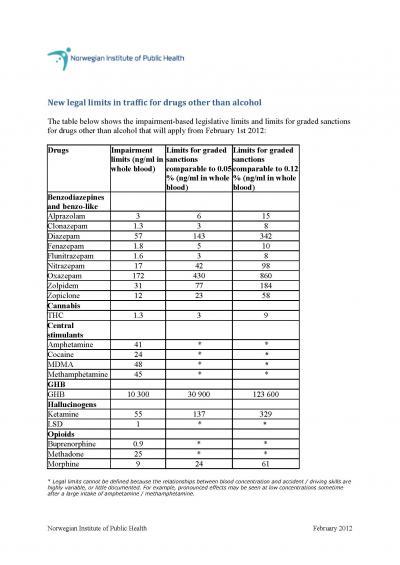Legal limits for twenty illegal drugs and medicines with an abuse potential have been introduced by the Norwegian government. Norway is the first country to define both impairment-based legislative limits and limits for graded sanctions for drugs other than alcohol. The Norwegian Institute of Public Health participated to provide the scientific basis for the new limits.
It is a criminal offence to drive a car or other motorised vehicle (mopeds, motorcycles, tractors, etc.) under the influence of alcohol, illegal drugs and medicines in Norway. Since 1936, there have been statutory limits on driving under the influence of alcohol, where the law "in all cases" assumes that driving skills are impaired. Since 2001, this limit has been 0.2 grams/litre. Punishment (fines, loss of driver's licence and / or imprisonment) is closely linked to alcohol levels in blood samples from the suspect.
20 substances covered by the new rules
There have not been similar limits for illegal drugs and medicines with an abuse potential (such as sedatives and painkillers). In such cases, the degree of impairment has been assessed by medical experts in each case. This assessment was made based on the concentration of intoxicants in blood samples, results from the standard medical examination, and any other relevant information.
With effect from February 1st 2012, the government introduced fixed concentration limits for 20 substances with an abuse potential. This will result in more equal laws for alcohol and other intoxicants and the judiciary will use significantly fewer resources to pass judgment. It is also an important signal that influence by non-alcohol drugs is not compatible with safe driving.
Exception for prescribed medicines
The system does not apply to therapeutic use of medicines with an abuse potential prescribed by a doctor. In such cases, the current system of individual evaluation will be used. This is partly because the accident risk is considered to be less for therapeutic use than for sporadic, illegal use because of tolerance development and the beneficial effect of treatment.
No rapid tests yet
There are currently no reliable rapid tests that can be used to indicate the influence of drugs other than alcohol at the roadside. The police will still have to evaluate impairment by means of field sobriety tests. In cases where the police suspect driving under the influence of drugs, a blood sample is sent for analysis by the Norwegian Institute of Public Health, and in recent years the number of positive samples has remained well above 90 per cent.

New legal limits in traffic for drugs other than alcohol : table showing the impairment based legislative limits and limits for graded sanctions for drugs other than alcohol, from Feb. 1, 2012.
(Photo Credit: Copyright: Norwegian Institute of Public Health)